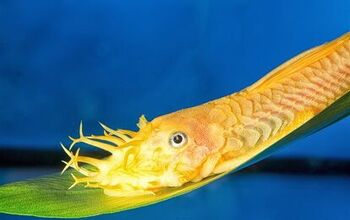6 Popular Aquarium Fish You Need To Avoid

Walk into just about any fish store and you’ll find a plethora of fish. If you go in unprepared, it’s easy to get caught up in the beauty of the tiny fish in the tiny tanks, and start buying them up left and right. When you get home and look into the background and care of these fish, you’ll learn what a horrible mistake you’ve made.
Many of the fish in stores are not meant to be kept by the average person. They grow far too large for most aquariums the average person has in their home. The sad reality is that in most cases, these fish will die long before a larger tank is needed.
Related: Take a Walk On the Wild Side of Bettas
The following list is of fish that should be avoided when adding stock to your new or existing aquarium. Part of being a responsible pet owner, of any kind, is knowing about your pets before you bring them into your home.
Common Pleco: As common as they may be, the common pleco has no place in the average home aquarium. These beautiful fish are typically just a few inches long when first purchased by an unsuspecting new tank owner, but they will inevitably grow to be rather large. A common pleco can reach lengths of up to 18 inches, and if cared for properly, will live 30 years. Many new aquarists think that they need an “algae eater” in their tank; however the truth of the matter is that it is easier to take care of the algae yourself than to get a fish that will never grow and live to its full expectancy. Unless you are equipped for this large of a fish, with a large bio load to go with it, skip the common pleco and go with a smaller variety such as a bristlenose pleco.
Related: 5 Fish Questions You Always Wanted to Ask
Arowana: These fish are stunning creatures that offer a glimpse into prehistoric times. That being said, they grow quickly, are aggressive, and prefer to be alone in an aquarium. While there are several different types, none of them are for the average aquarium owner. They require enormous tanks, a quality diet, and a well-equipped and knowledgeable keeper. The silver arowana, which is kept by experienced aquarists, can grow to be 35 inches long from head to tail. This is not a fish that should be tossed in a community tank, as it will only result in disaster.
Pacu: Aquarists looking for a large “manly” fish will often turn to the pacu. A pacu is a fish that is related to the piranha, but instead of sharp teeth, it has teeth similar to a human. They may be slightly gentler than a piranha when small, but don’t be fooled – these fish can reach 3 feet long and can weigh up to 55 lbs in the wild. These giants can easily break the tank glass with a swift hit, and since they are omnivorous, they will quickly pick off any tank mates that can fit into their massive jaws. If a beefy, manly fish is what you’re after, skip the pacu and go for some of the smaller varieties of cichlids that are available.
Red Tail Catfish: Many people adore catfish, and rightfully so. Catfish have a grace about them, while still being strong and agile. A commonly available catfish purchased by unsuspecting aquarists is the red tail cat fish (RTC). The RTC can reach amazing sizes of 5 feet long, quickly outgrowing even the most experienced fish keeper’s tanks. They will also eat most tank mates, which doesn’t make them the most popular fish in the aquarium.
Bala Sharks: The word “shark” appeals to those who don’t yet know the hobby. The truth is that these “sharks” are actually minnows. The first big problem is that they grow far too large for the home aquarium, reaching sizes of 16 inches. Consider that, because they are minnows, they are schooling fish and need to be kept in groups of 3 or more – that’s a lot of long fish to keep in a home aquarium. They need large tanks to be able to keep a group of them comfortably.
Iridescent Sharks: Once again, another “shark” that isn’t a shark at all. These are catfish that will grow to be 4 feet long, and can weigh nearly 100 lbs if grown to their full capability. They are commonly harvested in the wild for their meat. It’s fairly obvious that a fish that grows to this size cannot be kept by the average home aquarium owner.
This is far from an all-inclusive list of fish that should be avoided, but should serve as a suitable stepping stone, and learning opportunity, to always research before you buy. If you want to see large aquatic creatures, visit your local aquarium where they are kept the way they should be and can grow to their full potential instead of dying prematurely due to stunting in tiny tank.
Summer Davis is the mom of three kids, four dogs, and several tanks of fish. She boasts a passion for all animals, whether they are in the water or on land. This fish aficionado has kept many different species in her time, but holds a special place in her heart for wild and domestic bettas. When she’s not talking about fish, Summer “spins” her extra time as the director of a baton twirling organization.

Summer Davis is the mom of three kids, four dogs, and several tanks of fish. She boasts a passion for all animals, whether they are in the water or on land. This fish aficionado has kept many different species in her time, but holds a special place in her heart for wild and domestic bettas. When she's not talking about fish, Summer "spins" her extra time as the director of a baton twirling organization."
More by Summer Davis
























